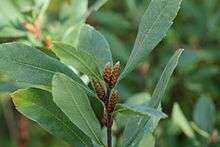Myrica gale
| Myrica gale | |
|---|---|
| | |
| Myrica gale foliage and immature fruit | |
| Scientific classification | |
| Kingdom: | Plantae |
| (unranked): | Angiosperms |
| (unranked): | Eudicots |
| (unranked): | Rosids |
| Order: | Fagales |
| Family: | Myricaceae |
| Genus: | Myrica |
| Species: | M. gale |
| Binomial name | |
| Myrica gale L. | |
| Synonyms | |
|
Gale palustris | |
Myrica gale is a species of flowering plant in the genus Myrica, native to northern and western Europe and parts of northern North America. Common names include Bog-myrtle[1] and sweetgale.[2] It is a deciduous shrub growing to 1–2 m tall. The leaves are spirally arranged, simple, 2–5 cm long, oblanceolate with a tapered base and broader tip, and a crinkled or finely toothed margin. The flowers are catkins, with male and female catkins on separate plants (dioecious). The fruit is a small drupe.
It typically grows in acidic peat bogs, and to cope with these difficult nitrogen-poor growing conditions, the roots have nitrogen-fixing actinobacteria which enable the plants to grow.
Uses
The foliage has a sweet resinous scent and is a traditional insect repellent, used by campers to keep biting insects out of tents. It is also a traditional component of Royal Wedding bouquets and is used variously in perfumery and as a condiment.
In north-western Europe (Germany, Belgium and Great Britain), it was much used in a mixture called gruit as a flavouring for beer from the Middle Ages to the 16th century, but it fell into disuse after hops supplanted gruit herbs for political and economic reasons.[3] In modern times, some brewers have revisited this historic technique and in Denmark and Sweden the plant is commonly used to prepare home-flavoured schnaps.
In some native cultures in Eastern Canada, the plant has been used as a traditional remedy for stomach aches, fever, bronchial ailments and liver problems. "The Creole Doctor", an 1886 article by Lafcadio Hearn, discusses the uses of the plant, known locally as "cirier batard," in Louisiana creole folk remedies.[4] In Scotland it has been traditionally used to ward off the Highland midge,[5] and it is marketed as an insect repellent and as an ingredient in some soaps.[6]
In 2007 there were plans to increase production of the plant in Scotland for use as an essential oil for treating sensitive skin and acne.[5] The plant has been listed as an abortifacient and therefore should not be consumed by women who are, or might be, pregnant.[7]

Sweetgale can grow in a narrow band in the intertidal zone, especially if logs have been washed into the estuary on which to establish itself. It is a favorite food of beavers, and low beaver dams can be found in the intertidal zone if sufficient sweetgale is present. The ponds thus formed are often completely submerged at high tide but retain enough water at low to provide refuge for fish. If too deep for predation by wading birds juvenile salmon may flourish.[8]
References
- ↑ "BSBI List 2007" (xls). Botanical Society of Britain and Ireland. Retrieved 2014-10-17.
- ↑ "Myrica gale". Natural Resources Conservation Service PLANTS Database. USDA. Retrieved 15 July 2015.
- ↑ "Gale (Myrica gale L.)". Gernot Katzer's Spice Pages. Retrieved 10 February 2014.
- ↑ Lafcadio Hearn, "The Creole Doctor: Some Curiosities of Medicine in Louisiana." New York Tribune, January 3, 1886.
- 1 2 Kelbie, Paul (12 February 2007). "Scotland's bog myrtle to fuel second oil boom". The Independent. Retrieved 10 February 2014. Archived here
- ↑ Evans, Emyr (27 September 2012). "It's Not Just about Our Ospreys". Liverpool Daily Post. Retrieved 10 February 2014. – via HighBeam Research (subscription required)
- ↑ "Myrica gale". Plants For A Future. Retrieved 10 February 2014.
- ↑ Hood, W. Gregory (2012). "Beaver in tidal marshes: dam effects on low-tide channel pools and fish use of estuarine habitat." (PDF). Wetlands. 32 (3): 408. Retrieved 11 June 2016.
External links
| Wikimedia Commons has media related to Myrica gale. |